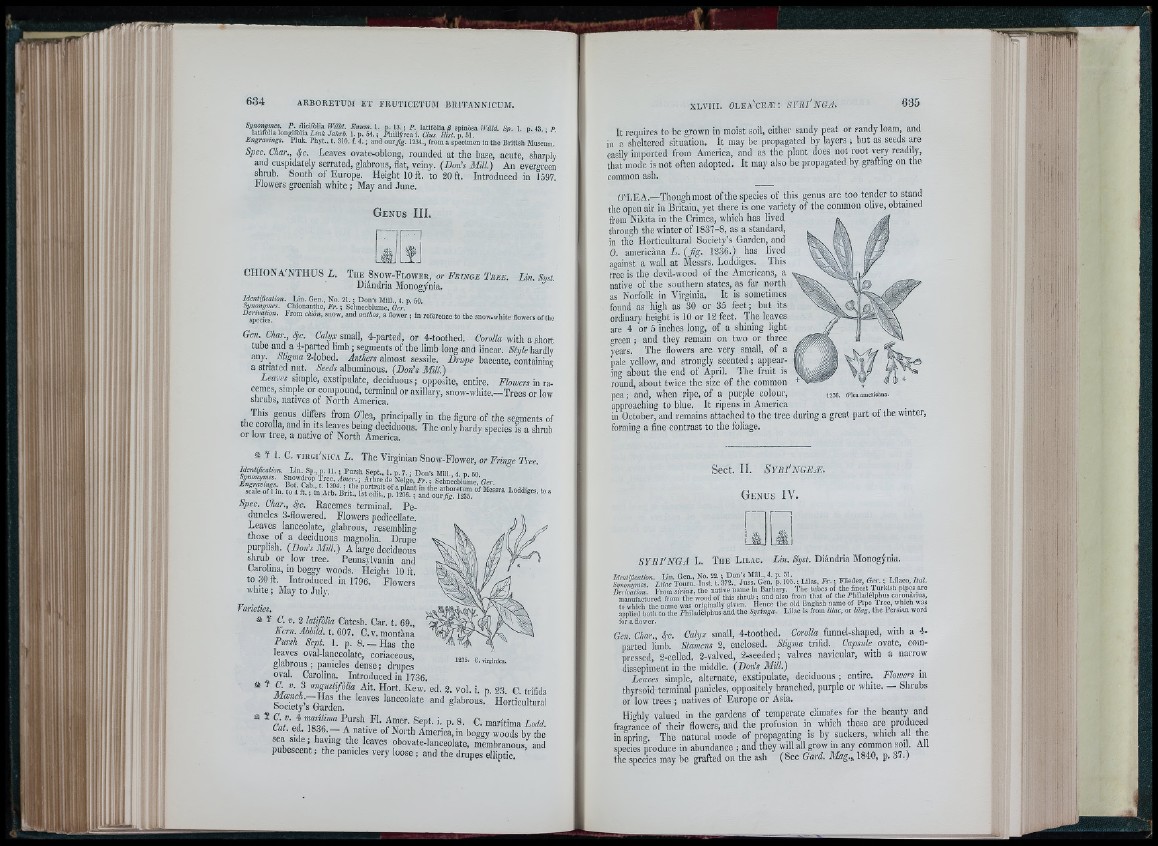
: ft !
li i
I
-, .■ A.'C'Í' ff'?*"- Fnum. I. p. 13. ; P. latifòlia ß spinósa Wim. Sp. 1. p
Utilòlia longifòlia L in k Jahrb. 1. p. 54. ; Phillÿrea 1. Clus. Hist. p. 51. :• 1 P.
specimen Engrauings. Pluk. Phyt., t. 310. f. 4 .; and o u r /g . 1234.. from ; in the British Museum.
Spec. Char., 4c. Leaves ovate-oblong, rounded at the base, acute, shai-ply
and cuspidately serrated, glabrous, flat, veiny, (Doris Mill.) An evergreen
^irub. South of Europe. Height 10 ft. to 20 ft. Introduced in 1597.
h lowers greenish white ; May and June.
G e n u s III.
CHIONA'NTHUS L. T h e S - n o w - F l o w e r , or F r i n g e T r e e . Lin, Sm t.
Diándria Monogynia.
ijlll. fexeil., iNU
Identification. Lin.Gen.,No. 21. : Don’s Mill., 4. p. 50.
Sf/nonymes. Chionanthe,- Fr."i-. ;-,
Scnneeblume, Gi?r.
Derivation. From c/iiön, snow, anthos, aflower ; in reference to the snow-white flowers ofthe
Gen Char 4c. Calyx small, 4-parted, or 4-toothed. Corolla with a short
tube and a 4-parted limb ; segments o fth e limb long and linear. Äy/e hardly
any. ^ Stigma 2-lobed. Anthers almost sessile. Drupe baccate, containinn-
a striaied nyt. Seeds albuminous. (Doris Mill.) °
Leaves simple, exstipulate, deciduous ; opposite, entire. Flowers in racemes,
simple or compound, terminal or axillary, snow-white.—Trees or low
shrubs, natives of North America.
This genus differs from O'lea, principally in the figure of the segments of
the corolla, and in its leaves being deciduous. The only hardy species is a shrub
or low tree, a native of North America.
äfe ¥ i. C. v irg i'm c a L. The Virginian Snow-Flower, or Fringe Tree.
Spec. Char., 4c. Racemes terminal. Peduncles
3-flowered. Flowers pedicellate.
Leaves lanceolate, glabrous, resembling
those of a deciduous magnolia. Drupe
purplish. (Doris Mill.) A large deciduous
shrub or low tree. Pennsilvania and
Carolina, in boggy woods. Height 10 ft.
to 30 ft. Introduced in 1796, Flowers
white ; May to July.
Farieties.
^ Í C. V. 2 latifòlia Catesb. Car. t. 69.,
Kern. Abbild. t. 607. C.v. montàna
Pursh Sept. 1. p. 8 .— Has the
leaves oval-lanceolate, coriaceous,
glabrous ; panicles dense; drupes
oval. Carolina. Introducedin 1736.
1235. C. virginica.
^ Hort. Kew. ed. 2. vol. i. p. 23. C trífida
^ d ? y ’s~Gm?e! ' “ reolate and glabrous. Horticultural
* cCarti.e edd . T18s36i.f —“ A native of NorthS eAptm- e'•r icpa., 8in. bCog. gmy awríotiomdsa bLyo dtdh.e
t obovate-lanceolate, membranous, and
pubescent ; the panicles very loose ; and the drupes elliptic
Tt requires to be grown in moist soil, either sandy peat or sandy loam, and
in a sheltered situation. It may be propagated by layers ; but as seeds are
easily imported from America, and as the plant does not root very readily,
that mode is not often adopted. I t may also be propagated by grafting on the
common ash.
O'LEA.—Though most ofthe species of this genus are too tender to stand
the open air in Britain, yet there is one variety of the common olive, obtained
from Nikita in the Crimea, which has lived
through the winter of 1837-8, as a standard,
in thè Horticultural Society’s Garden, and
0 . americana I j . ( f i g . 1236.) has lived
against a wall at Messrs. Loddiges. This
t?ee is the devil-wood of the Americans, a
native of the southern states, as far north
as Norfolk in Virginia. It is sometimes
found as high as 30 or 35 feet; but its
ordinary height is 10 or 12 feet. The leaves
are 4 or 5 inches long, of a shining light
green ; and they remain on two or three
years. The flowers are very small, of a
pale yellow, and strongly scented ; appearing
about the end of April. The fruit is
round, about twice the size of the common
pea; and, when ripe, of a purple colour, 1236. o'leaamericàna.
approaching to blue. It ripens in America
in October, and remains attached to the tree during a great part of the winter,
forming a fine contrast to the foliage.
Sect. II. SVRfNGEÆ.
G e n u s IV.
SYRTNGA L. T h e L i l a c . Lin. Syst. Diandria Monogynia.
t o t t W fe ”j u s ? Gei.' P-1®. ; Lilas, Fr. ; F li e to , Ger. j Lllaco, Ital.
Derivation From sirinx, the native name in Barbary. The tubes of the finest Turkish pipes are
¿Lrufart'ureil fi-oivi tlie ivood of tills shrub ; and also from th at of the Philadélphus corqnarius,
to whirt the iiatSTvias originally given. Hence the old English name of Pipe Tre e, whrcli was
appTed U i , to the Philadélphus and the Syringa. Lilac is from lilae. or I,lag. the Persian word
for a flower.
Gon Char., f r . Cahj.v small, 4-toothed. Corolla funnel-shaped, with a 4-
parted limb. Stamens 2, enclosed. Stigma trifid. Capsule ovate, compressed,
2-celled, 2-valved, 2-seeded; valves navicular, with a narrow
dissepiment in the middle. {Lords Mill.) _
Leaves simple, alternate, exstipulate, deciduous ; entire. Blowen m
thyrsoid terminal panicles, oppositely branched, purple or white. — Shrubs
or low trees ; natives of Europe or Asia.
Hiohly valued in the gardens of temperate climates for the beauty and
fragrance of their flowers, and the profusion in which ffiese are p ro /c e d
in spring. Tlie natural mode of propagating is by suckers, which a ! the
species produce in abundance ; and they will all grow m any common soil. All
the species may be gi-aftcd on the ash (See Gard. Ma.g.. 1840, p. 37.)